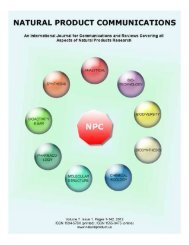This Issue is Dedicated to the Memory of Professor Ivano Morelli
This Issue is Dedicated to the Memory of Professor Ivano Morelli
This Issue is Dedicated to the Memory of Professor Ivano Morelli
You also want an ePaper? Increase the reach of your titles
YUMPU automatically turns print PDFs into web optimized ePapers that Google loves.
NPC<br />
Natural Product Communications<br />
Kenyaloside, a Novel O,O,O-Triglycosylated Naphthalene<br />
Derivative from <strong>the</strong> Exudate <strong>of</strong> Kenyan Aloe Species *<br />
2006<br />
Vol. 1<br />
No. 12<br />
1085 - 1088<br />
Giovanna Speranza a,* , Daniela Monti b , Sergio Crippa a , Paola Cairoli a , Carlo F. <strong>Morelli</strong> a and<br />
Paolo Manit<strong>to</strong> a<br />
a Dipartimen<strong>to</strong> di Chimica Organica e Industriale, Università degli Studi di Milano, via Venezian 21,<br />
20133 Milano, Italy<br />
b Istitu<strong>to</strong> di Chimica del Riconoscimen<strong>to</strong> Molecolare, C.N.R., via Mario Bianco 9, 20131 Milano, Italy<br />
giovanna.speranza@unimi.it<br />
Received: July 11 th , 2006; Accepted: September 2 nd , 2006<br />
<strong>Dedicated</strong> <strong>to</strong> <strong>the</strong> memory <strong>of</strong> Pr<strong>of</strong>essor <strong>Ivano</strong> <strong>Morelli</strong>.<br />
A new naphthalene O,O,O-triglycoside, kenyaloside (1), was <strong>is</strong>olated from <strong>the</strong> dried exudate <strong>of</strong> Kenyan Aloe species,<br />
a bittering and laxative agent. Its structure was establ<strong>is</strong>hed by combined spectral and chemical methods as<br />
1-(β-D-glucopyranosyloxy)-8-(α-L-rhamnopyranosyloxy)-3-(β-D-xylopyranosyloxymethyl)naphthalene.<br />
Keywords: aloes, Aloe ferox, naphthalene O,O,O-triglycoside, kenyaloside.<br />
As part <strong>of</strong> a systematic chemical investigation in<strong>to</strong><br />
Aloe exudates (bitter aloes) [1], <strong>the</strong> structural<br />
elucidation <strong>of</strong> a new water-soluble constituent <strong>of</strong> <strong>the</strong><br />
exudate <strong>of</strong> Kenyan Aloe species <strong>is</strong> reported here. <strong>Th<strong>is</strong></strong><br />
exudate, flowing from <strong>the</strong> cut leaves <strong>of</strong> Aloe ferox<br />
Miller and <strong>of</strong> its hybrids with A. spicata and<br />
A. africana growing in Kenya [2, 3], when dried, <strong>is</strong><br />
used as a bittering agent and as a purgative, similarly<br />
<strong>to</strong> Cape aloes [4, 5]. The drug has been reported <strong>to</strong><br />
contain a number <strong>of</strong> polyketide metabolites (such as<br />
O- and/or C-glucosides) belonging <strong>to</strong> <strong>the</strong> families <strong>of</strong><br />
6-phenyl-2-pyrones, 5-methyl-7-hydroxychromones,<br />
and 1,8-dihydroxyanthrones (see Ref. 3 for a<br />
complete l<strong>is</strong>t <strong>of</strong> such compounds).<br />
The structure <strong>of</strong> <strong>the</strong> new product, named kenyaloside<br />
(1), was determined by spectral and chemical<br />
methods. To our knowledge, it represents <strong>the</strong> first<br />
example <strong>of</strong> a naphthalene glycoside both occurring in<br />
Aloe species and bearing three different O-glycosyl<br />
residues [4, 5].<br />
Part 19 in <strong>the</strong> series “Studies on Aloe”. For Part 18, see Ref. 1<br />
The aqueous extract <strong>of</strong> <strong>the</strong> dried exudate <strong>of</strong> Kenyan<br />
Aloe species, after partitioning with ethyl acetate, was<br />
lyophilized <strong>to</strong> afford a residue that was<br />
chroma<strong>to</strong>graphed successively on silica gel and<br />
Sephadex LH-20 columns. Kenyaloside (1) was<br />
obtained in ca. 0.1% yield (based on <strong>the</strong> starting<br />
drug). Its molecular formula, C 30 H 40 O 17 , was derived<br />
from ESI-HRMS (found: m/z 695.21326, calcd for<br />
[M+Na + ] m/z: 695.21577). The presence <strong>of</strong> three<br />
O-glycosyl residues was suggested by inspection <strong>of</strong><br />
chemical shifts and coupling constants in <strong>the</strong> 1 H and<br />
13 C NMR spectra <strong>of</strong> 1 (Table 1); in addition, <strong>the</strong><br />
NOESY spectrum revealed two significant<br />
associations between <strong>the</strong> anomeric pro<strong>to</strong>n at δ 5.77<br />
and <strong>the</strong> upfield aromatic pro<strong>to</strong>n, and between ano<strong>the</strong>r<br />
anomeric pro<strong>to</strong>n (at δ 4.31) and both <strong>the</strong> aromatic<br />
pro<strong>to</strong>n at δ 7.48 and an Ar-CH 2 group (AB system:<br />
δ 4.73, 4.94, J = 12.4 Hz). 1 H and 13 C signals due <strong>to</strong><br />
four aromatic C-H groups, <strong>to</strong>ge<strong>the</strong>r with <strong>the</strong> values <strong>of</strong><br />
1 H- 1 H coupling constants and mutual NOEs, were<br />
indicative <strong>of</strong> a 1,2,3,8-tetrasubstituted naphthalene<br />
nucleus.







